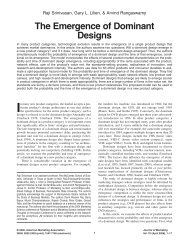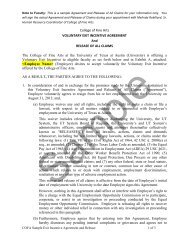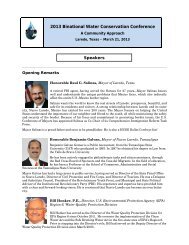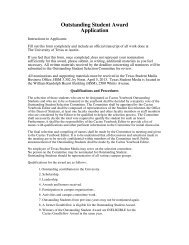Invited Talks: Transition Metal Oxides - University Blog Service - The ...
Invited Talks: Transition Metal Oxides - University Blog Service - The ...
Invited Talks: Transition Metal Oxides - University Blog Service - The ...
You also want an ePaper? Increase the reach of your titles
YUMPU automatically turns print PDFs into web optimized ePapers that Google loves.
<strong>The</strong> John B. Goodenough Symposium in Materials Science & Engineering –<br />
In Honor of His 90 th Birthday<br />
<strong>The</strong> <strong>University</strong> of Texas at Austin, Austin, Texas<br />
October 26-27, 2012<br />
Electrochemical and electronic properties of tetrahedral silicates Li2MSiO4 as cathode<br />
materials for Li-ion batteries<br />
R. C. Longo, K. Xiong, Santosh KC and K. Cho<br />
Department of Materials Science & Engineering, <strong>The</strong> <strong>University</strong> of Texas at Dallas, 800 W. Campbell<br />
Road, Richardson, TX, 75080, USA<br />
Emails: roberto.longo@utdallas.edu and kjcho@utdallas.edu<br />
Abstract Body in Space Below:<br />
(Please use single space, Times New Roman or similar font, size 12, and limit to 250 Words. Please DO NOT exceed the space<br />
below.)<br />
Using density functional theory (DFT), we investigate the structural, electronic and electrochemical<br />
properties of different tetrahedral silicate polymorphs recently synthesized and experimentally<br />
characterized. This family of compounds can insert and/or extract two Li atoms in two consecutive<br />
electron redox processes, giving rise to a much higher capacity (330 mAh/g) than that of the current<br />
cathodes (e.g., 160 mAh/g for LiCoO 2 ). Our DFT study includes the lithiated and both semi- and fully<br />
delithiated phases, in order to analyze how the charge/discharge process affects their structural stability.<br />
We also describe the electronic structure of these compounds accurately, trying to point out the main<br />
favorable mechanisms for both ionic and electronic conductivities. Finally, we show that, with suitable<br />
doping, it is possible to tailor the voltage and band gap of these silicates, improving their performance and<br />
making them promosing candidates as new cathode materials of rechargeable Li-ion batteries.<br />
Acknowledgments<br />
<strong>The</strong> authors also acknowledge the Texas Advanced Computing Center (TACC) for providing HPC<br />
resources.
















